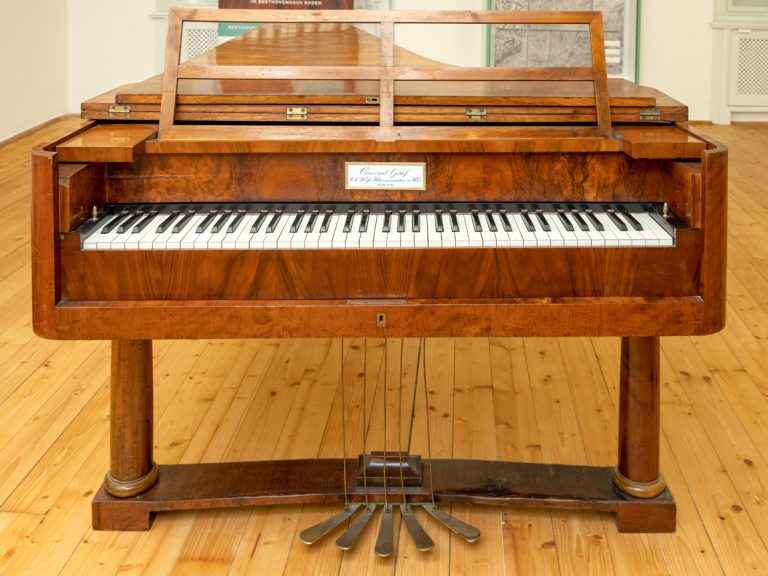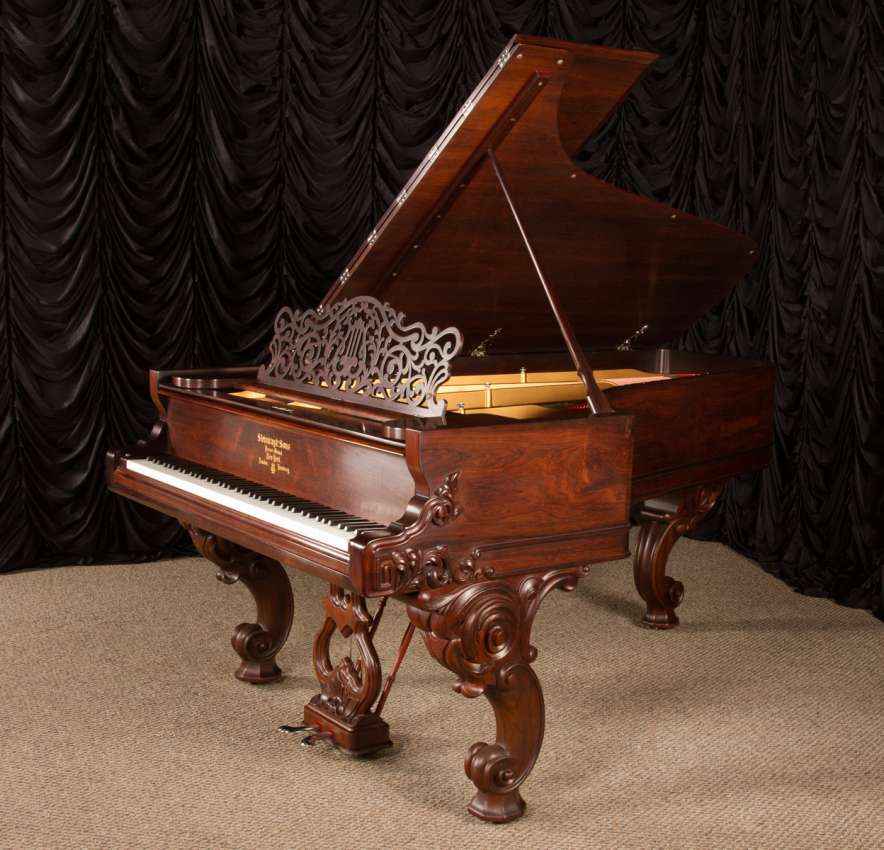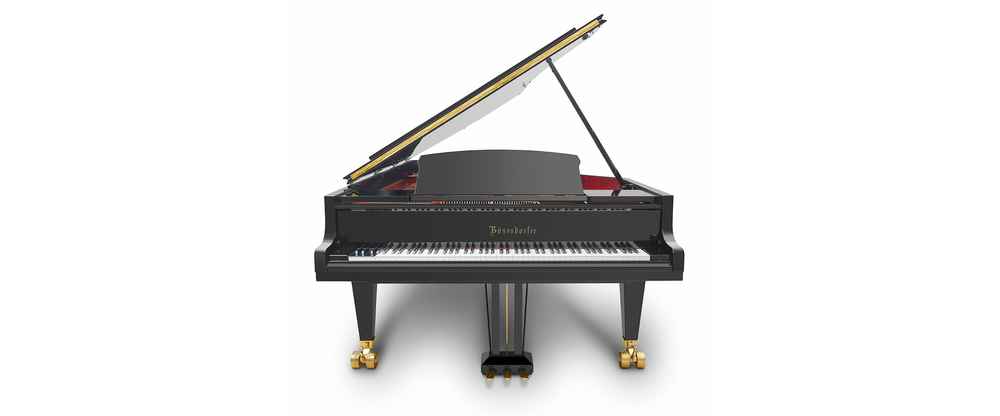How many keys on a piano?


The range of keyboard instruments has increased over the years. The earliest keyboards had as few as 1-3 octaves. Early pianos had only 4 octaves, harpsichords often extended over five octaves (>60 keys) in the 18th century, and most acoustic pianos manufactured since about 1870 have 88 keys, or 7 ¼ octaves.
That means we may need to be more precise. We can’t really answer the question of how many keys are on a piano, because it depends on the piano and the time. But we can answer the question of how many keys are on a Baroque Era piano, or how many keys are on a Romantic Era piano, or how many keys are on a digital piano.
One of the most common conundrums my students face when I am teaching piano lessons is determining the piano that’s just right for them. Nowadays pianos come in all shapes and sizes. These different sizes do come with some pros and cons so choosing between one or another is much like choosing between many other things in life such as a car, house, or electrical appliance. How do you know which one is the right one for you?
In this article, we’ll first learn about how many keys are on the different pianos, and give you some small advice about which may be the best fit for you.
The number of keys on a piano depends upon the time
After choosing between a grand, upright, or digital piano, one of the most common questions I get when helping students pick a piano is how many keys they should get. Pianos and piano keyboards today have 3 main keyboard configurations; the 88 key, the 72 key, and the 66 key configurations.
It’s also interesting that back when the piano was first invented composers like Mozart and Beethoven had to go through the exact same dilemma of choosing the number of keys on the piano. As the piano evolved, there were new pianos with more keys, but not everyone had them. As a result, they couldn’t always write music for the piano with the most keys, because that meant it might reduce the number of people who could play the music.
When Bartolomeo Cristofori first invented the piano in 1700, his piano had a range of 4 octaves, which is a total of 49 keys. As a consequence, this greatly influenced the way music was composed. Since the new instrument was able to play lower and higher notes than its predecessor, composers were able to compose, and of course play, music with greater pitch ranges.
Today we would think of 49 keys as a small range, but for Cristofori and his time this was a large and expanded range.
Most classical music on the piano follows the timeline of advances in the piano and the increasing number of keys on the piano. This means as you progress through the ages with composers like Bach (1685-1750), to Mozart (1756-1791) and Beethoven (1770-1827), their pianos increased in the number of keys, too.
While you could play early Handel (1685-1759) on a 49 key piano, that’s not enough for Mozart. And you’ll need 76 keys to play the music of Liszt (1811-1886) or Chopin (1810-1849) in the Romantic Era. 88 keys became standard around 1870, and so most classical music after that time would require an 88 key piano. Having a standard 88-key piano will allow you to play any classical music, which is what we’d recommend for any classical piano student.




We don't know with certainty who created the first piano with 88 keys. According to the British Archives, it was Pohlmann and Sons. However, the first company to manufacture the 88 key piano was Steinway in 1869, and it has been the standard ever since.

While we think of 88 keys as standard, that’s probably what Mozart thought about 61 keys. So the 88 key piano may not be the standard in the future.
Some modern pianos have even more notes such as the Bösendorfer 290 "Imperial" which has 97 keys, and a Stuart & Sons model has a world-record 108 keys.
Critics would argue that the human ear can’t really hear music beyond 88 keys, so it isn’t worth adding more. Obviously Bösendorfer and Stuart & Sons would disagree.


Does one size fit all?
Adding more and more keys can make the piano more difficult to play. That is, the keys at the ends of the piano range are physically further away from the center where the player sits, and require a longer reach to play. There have been attempts to make the keys smaller to reduce this distance, and also make the piano easier to play for people with less than large stature.
Over the last three hundred years, the octave span distance found on historical keyboard instruments (organs, virginals, clavichords, harpsichords, and pianos) has ranged from as little as 4.9 in to as much as 6.7 in. Modern piano keyboards ordinarily have an octave span of 6.5 inches resulting in the width of black keys averaging about 0.54 in. and white keys about 0.93 in. at the base, disregarding space between keys. This difference can negatively affect a pianist’s ability to play certain pieces because the fingers have to stretch that much more to reach notes as opposed to when the piece was first composed on a keyboard instrument with smaller distances between the keys.
In recent years, there has actually been evidence of a correlation between pianists with smaller hand and hand or arm injuries. Several reduced-size key standards have been proposed for these pianists.
A 7/8 size, which provides a 5.5 octave span, was developed by Canadian Christopher Donison in the 1970s. This size, along with the 15/16 size (6.0 in octave span) and a smaller size (5.1 in octave span) have since been developed and marketed by Steinbuhler & Company in Pennsylvania.
This is not without precedent. In fact, the “normal size” modern upright bass is typically only ¾ or sometimes ⅞ size. A full size upright bass is too large and cumbersome for the majority of people to play.
Since 2013, a global network of pianists, teachers and performing arts health professionals has been increasingly advocating for change to the 'one size fits all' approach to piano keyboard manufacturing by major companies. This network is known as PASK (Pianists for Alternatively Sized Keyboards). U.S. pianist Hannah Reimann has promoted piano keyboards with narrower octave spans and has a U.S. patent on the apparatus and methods for modifying existing pianos to provide interchangeable keyboards of different sizes. Narrower keyboards are available from Steinway & Sons in new grand pianos or as a retrofit to existing pianos.
Not all piano octaves have 12 keys
There have also been variations in the design of the keyboard to address technical and musical issues. The earliest designs of keyboards were based heavily on the notes used in Gregorian chant (a type of liturgical music) and as such would often include B♭ (which has since become a black key) and B♮ both as white keys, with the B♮ at the leftmost side of the keyboard and the B♭ at the rightmost. This meant that back then an octave would have eight white keys and only four black keys. The emphasis on these eight notes would continue for a few centuries.
During the sixteenth century some harpsichords were constructed with the G♯ and E♭ keys split into two. One portion of the G♯ key operated a string tuned to G♯ and the other operated a string tuned to A♭, similarly one portion of the E♭ key operated a string tuned to E♭, the other portion operating a string tuned to D♯. This type of keyboard layout, known as the enharmonic keyboard, extended the flexibility of the harpsichord, enabling composers to write keyboard music calling for harmonies containing the so-called wolf fifth (G-sharp to E-flat), but without producing aural discomfort in the listeners.
This makes it difficult to compare the number of keys of the enharmonic keyboard to a conventional keyboard. As you'll see below, each octave on Vicentino's enharmonic keyboard has up to 18 keys per octave.

Color of the keys
The arrangement of longer keys for the white keys with shorter keys for the black keys dates to the 15th century.
Many keyboard instruments dating from before the nineteenth century, such as harpsichords and pipe organs, have a keyboard with the colors of the keys reversed from today’s standard: the white keys are made of ebony and the black keys are covered with softer white bone such as ivory.

The reason for this was due to the fact that ivory was a luxurious material and so was scarcer. In later centuries this would be switched to the modern layout because it was actually easier to see the spaces in between the keys when the larger keys were white (ivory) and the smaller keys were black (ebony).
A few electric and electronic instruments from the 1960s and the following decades have also done this. Some examples include Vox's electronic organs of the 1960s, Hohner's Clavinet L, and Roland's digital harpsichords.
How many keys are on a digital piano?
Modern synthesizer and digital keyboards commonly have either 61, 76 or 88 keys. There are also small MIDI controllers available with 25 keys. These digital systems allow shifting octaves, pitch, and "splitting" ranges dynamically, which, in some cases, reduce the need for dedicated keys. However, as mentioned previously, smaller keyboards will typically limit which musical scores can be played.
Since these keyboards are not typically intended for classical music, it may not be necessary to have 88 keys on them.
Theoretically, these digital keyboards could have more keys than the Boesendorfer or Stuart pianos, because they would not be limited by the physics of the strings, and could many more high notes.
But with the sound quality being inferior, and the ability to change octaves digitally, the increased size just makes this impractical.
Conclusion
As we have journeyed through the centuries, keyboard instruments have transformed a lot since their invention; from the color choices of the keys themselves, to the range and width of the keys and keyboard, and the number of keys on a keyboard. All these changes have provided pianists with a wide range of repertoire and sound possibilities.
There are even other keyboard instruments which we didn’t discuss in this article that continue to push the envelope on what is possible to play and what can enable a composer or songwriter to come up with new and exciting music.
So how many keys are on a piano again? Somewhere between 25 and 108.
However, in the end, for most students of the piano, the standard layout of the modern piano has 88 keys, and this should suffice for a lifetime.
As you continue to grow with the instrument just remember that there is a wealth of variants that can help you to pursue your musical dreams and goals and whichever you choose to use will still help you focus on the most important aspect: make the beautiful music you hear in your heart in mind.
Related



